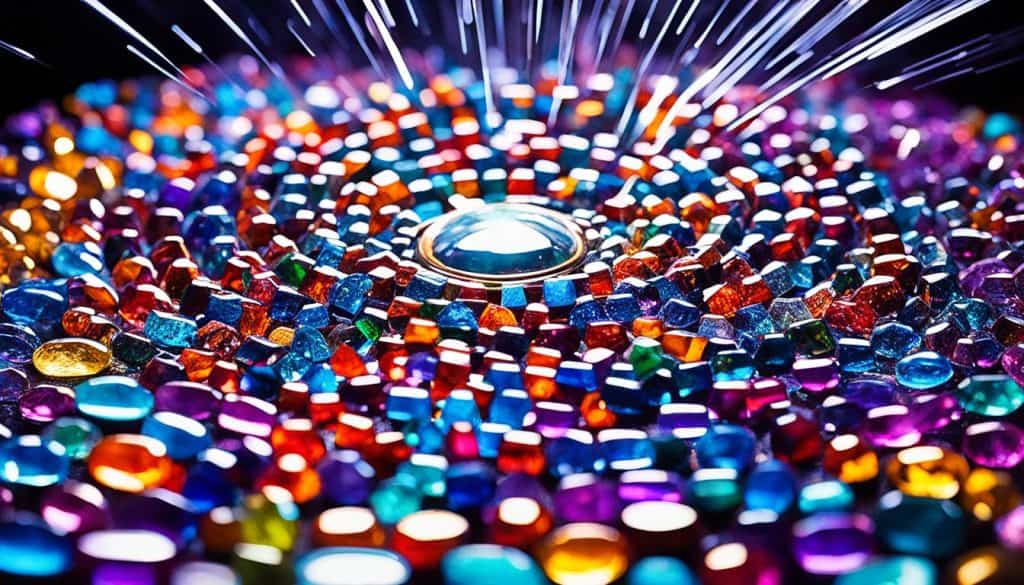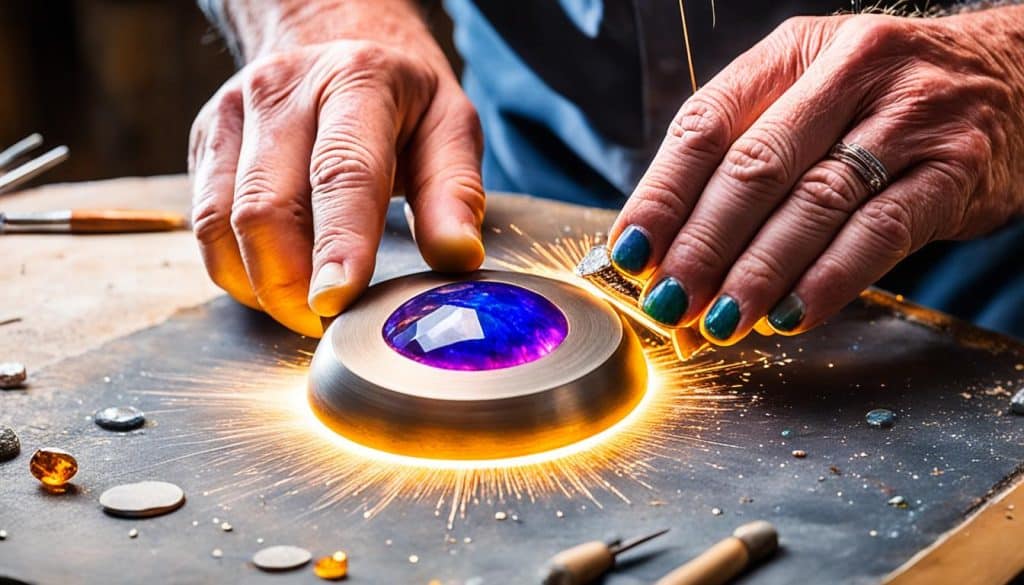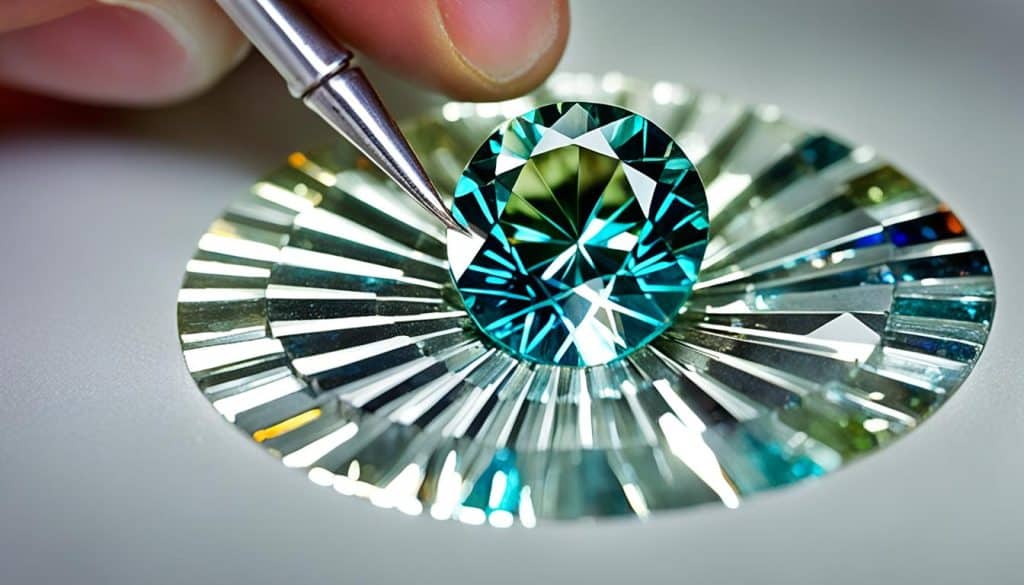Have you ever held a beautifully cut gemstone in your hands, mesmerized by its radiant colors and exquisite sparkle? For me, the allure of gemstone craftsmanship goes beyond mere aesthetics. It’s an art form that captures the essence of time, skill, and dedication. Transforming raw materials into works of art that stand the test of time.
Gem cutting, also known as lapidary arts, involves shaping and polishing gemstones to enhance their natural beauty and maximize brilliance. It’s a process that requires precision, skill, and an intimate understanding of the properties of different gemstones. From planning and designing the gem’s transformation to selecting the perfect shape, size, color, and clarity, artisans blend tradition with innovation to breathe life into each precious stone.
The commitment to quality and assurance is evident in every step of the gem cutting process. Artisans use tools like lapidary saws, faceting machines, and polishing compounds for flawlessness. They also use technology to improve precision, efficiency, and consistency, blending ancient art with modern innovation.
Gemstone craftsmanship goes beyond just technique. It includes values that matter in our world today. Using sustainable practices and responsible sourcing shows our care for the planet and people. Ethical craftsmanship ensures the gemstones’ integrity and helps make the industry more sustainable and compassionate.
Exploring gemstone craftsmanship, I’m amazed by the various lapidary arts. Gemstone tumbling shows the raw beauty inside each stone. Cabbing highlights the smooth, rounded shapes of the gem. Faceting brings out the brilliance and sparkle. And carving is the top form, needing deep artistic sense and understanding.
A well-cut gemstone can be worth more than a poorly cut one, even if it’s smaller or from somewhere else. This shows how important gemstone craftsmanship is. Imagine a rare 59.6-carat pink diamond, the Pink Star, selling for $71.2 million because of its amazing cut, color, and clarity.
Key Takeaways:
- Gem cutting involves shaping and polishing gemstones to enhance their natural beauty and maximize brilliance.
- Artisans blend tradition with innovation to create exquisite gemstone transformations.
- Implementation of sustainable practices aligns with contemporary values in the gem-cutting industry.
- Gemstone tumbling, cabbing, faceting, and carving are different forms of lapidary arts.
- A well-cut gemstone can fetch a higher price due to its exceptional quality.
Gemstone Tumbling: Revealing the Beauty Within
Gemstone tumbling is a fun and easy lapidary technique. It lets you bring out the hidden beauty in rough gemstones. It’s great for families and jewelry makers looking for a creative hobby.

Unveiling the Brilliance
Gemstone tumbling puts rough gem material in a tumbler with abrasive stuff. The tumbler spins, shaping and polishing the stones over time. This makes the stones smooth and shiny, showing off their natural colors and patterns.
Start with rough stones and use finer abrasives as you go. This way, you get a glossy surface that highlights the gemstone’s beauty. It’s a great way to make stunning pieces for jewelry or decoration.
A Gateway to Creativity
Gemstone tumbling lets you see the beauty in stones and sparks creativity. You can use the polished stones in jewelry, like wire-wrapped pendants or earrings. This adds a natural elegance to your creations.
It’s also a great way to learn about minerals. You can make a “rock identification” game with the tumble stones. This game is perfect for geology fans and helps them explore different gem materials.
The Beauty Beyond Jewelry
Gemstone tumbling is not just for jewelry or learning. It’s also used in home décor and Feng Shui. People put the stones in vases or place them in certain areas to improve the energy.
Choosing birthstone tumble stones for gifts is also popular. These gifts show you care and value sentiment and thoughtfulness. The unique touch of a tumbled stone makes these gifts even more special.
Gemstone tumbling is a journey that reveals the beauty in rough stones. It’s perfect for jewelry makers, geology fans, or anyone who loves natural beauty. It’s a rewarding and creative hobby for everyone.
Cabbing: The Art of Creating Cabochons
Cabbing, or cabochon cutting, is a special art in gemstone craftsmanship. It involves cutting gems with a flat bottom and a curved top. This technique is popular for stones like opal and turquoise, which have unique colors and patterns.

Cabochons are different from faceted gems. They don’t have flat surfaces to make them sparkle. Instead, their smooth surfaces show off the gem’s natural beauty. This makes them very appealing to jewelry lovers.
Cabochon Stones: A Versatile Choice
About 70% of cabochons are made from semi-precious stones like quartz and agate. These stones are chosen for their strength and beauty. They are more durable than glass cabochons, which can break easily.
Lapidary grinders are key in making cabochons. Brands like Diamond Pacific and Hi-Tech Diamond make these machines. Dopping is another technique used to attach the stone to a stick for grinding and shaping safely.
Choosing Between Cabochon and Faceted Gems
Choosing between cabochons and faceted gems depends on personal taste and the jewelry design. Faceted gems are often used in fancy jewelry, like engagement rings. They sparkle a lot because of their precise cutting and polishing.
Cabochon stones are great for showing off unique colors and patterns. They are perfect for jewelry that looks natural or vintage. These stones highlight special effects like chatoyancy or asterism.
Pricing Cabochon Stone Jewelry
When selling cabochon jewelry, think about the cost of materials, equipment, and your time. Setting a fair price is important for selling and making a profit. Pricing can vary based on the quality of the cabs.
It’s good to sell cabs at prices that appeal to different customers. Some people pay a lot for high-quality cabs, while others look for more affordable options. The price of cabochon stones can depend on their quality and rarity.
Artisans should price their work based on its uniqueness and the skill put into it. Making high-quality cabs or taking custom orders can help them stand out and make a profit. Pricing should reflect the artistry and creativity in each piece.
True art is more than just time and materials. The value of a Picasso painting comes from its artistic quality, not just the canvas and paint. Similarly, the price of cabochon jewelry should reflect the craftsmanship and creativity behind it.
Faceting: Unleashing the Brilliance of Gemstones
Gem faceting is a skilled process that cuts and polishes gemstones to make them sparkle. It’s all about reflecting light to show off the stone’s beauty. This art needs a lot of precision to make the stone look its best.
How many facets a gemstone has depends on its cut. For example, diamonds get a brilliant cut, while emeralds get a step cut. Each cut has its own special look.
To get the right look, cutters use tools like saws and grinders. They also use special compounds for polishing. The last step is very detailed to make sure the gem looks perfect.
Now, Computer-Aided Design (CAD) is changing the game in gem faceting. CAD lets cutters make digital models before cutting the stone. This helps them be more accurate and avoid mistakes.
Automated machines with lasers and sensors are also making a big difference. These machines help cutters make flawless gems with great precision.
Today, finding gemstones that are ethically sourced is very important. People want gems that are mined responsibly. This helps the environment and supports fair trade.
Gem Factory is a top name in the gemstone industry. They’ve been around for 20 years and offer a wide range of gemstones. They make sure all their gems come from trusted suppliers around the world.
DWS Jewellery is also well-known for their gem cutting skills. Their team works hard to make each piece perfect. They focus on precision and beauty in every jewelry piece.
The work of DWS Jewellery makes gemstones look amazing. They use special cuts and angles to bring out the best in each stone. Every gemstone gets a lot of care to make it look stunning.
Faceting not only shows off gemstones but can also be profitable. There’s a growing demand for unique jewelry with custom gem cuts. This means cutters have to keep coming up with new ideas.

In the end, gem faceting is a precise art that brings out the beauty in gemstones. With new technology and a desire for unique jewelry, the art of faceting is always changing. It offers both creative fulfillment and business opportunities.
Conclusion: The Timeless Beauty of Gemstone Craftsmanship
Gemstone craftsmanship has been around for centuries, starting in ancient Mesopotamia and Egypt. It got a boost during the Renaissance in Europe and keeps evolving with new technology. Techniques like intaglio and cameo carving add deep meaning to gemstone art, showing its importance in culture.
Today, gemstone jewelry is still popular, both as art and as an investment. Artisans make each piece with care, mixing old and new skills. Kings Mines shows this mix with a collection of gemstones from all over the world, like emeralds and amethysts.
Gemstone earrings come in many styles, from simple studs to big chandeliers. They are timeless, showing elegance and value. Fashion changes, but these earrings stay classic. Now, gemstone art includes new trends like pearls and wood, and unique designs.
The industry is also focusing on being sustainable, using stones mined ethically and supporting fair trade. Many techniques, like stone setting and beading, are used to make beautiful jewelry. When picking stones, think about their color, clarity, cut, size, and how hard they are.
To keep gemstone jewelry looking great, clean it often and store it in a soft pouch or box. Making jewelry with precious stones involves getting materials, designing, preparing stones, putting the jewelry together, and adding the final touches. This results in a piece that can be worn or given, showing the lasting beauty of gemstone craftsmanship.
